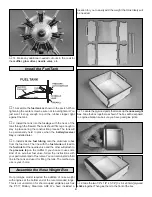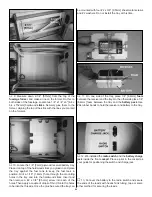
altitude. While full throttle is usually desirable for take off, most
models fly more smoothly at reduced speeds.
Take it easy with the PT-17 Military Stearman ARF for the
first few flights, gradually getting acquainted with it as you
gain confidence. Adjust the trims to maintain straight and
level flight. After flying around for a while, and while still at a
safe altitude with plenty of fuel, practice slow flight and
execute practice landing approaches by reducing the
throttle to see how the model handles at slower speeds. Add
power to see how she climbs as well. Continue to fly around,
executing various maneuvers and making mental notes (or
having your assistant write them down) of what trim or C.G.
changes may be required to fine tune the model so it flies
the way you like. Mind your fuel level, but use this first flight
to become familiar with your model before landing.
To initiate a landing approach, lower the throttle while on the
downwind leg. Allow the nose of the model to pitch
downward to gradually bleed off altitude. Continue to lose
altitude, but maintain airspeed by keeping the nose down as
you turn onto the crosswind leg. Make your final turn toward
the runway (into the wind) keeping the nose down to
maintain airspeed and control. Level the attitude when the
model reaches the runway threshold, modulating the throttle
as necessary to maintain your glide path and airspeed. If
you are going to overshoot, smoothly advance the throttle
(always ready on the right rudder to counteract torque) and
climb out to make another attempt. When you’re ready to
make your landing flare and the model is a foot or so off the
deck, smoothly increase up elevator until it gently touches
down. Once the model is on the runway and has lost flying
speed, hold up elevator to place the tail on the ground,
regaining tailwheel control.
One final note about flying your model. Have a goal or flight
plan in mind for every flight. This can be learning a new
maneuver(s), improving a maneuver(s) you already know, or
learning how the model behaves in certain conditions (such
as on high or low rates). This is not necessarily to improve
your skills
(though it is never a bad idea!), but more
importantly so you do not surprise yourself by impulsively
attempting a maneuver and suddenly finding that you’ve run
out of time, altitude or airspeed. Every maneuver should be
deliberate, not impulsive. For example, if you’re going to do
a loop, check your altitude, mind the wind direction
(anticipating rudder corrections that will be required to
maintain heading), remember to throttle back at the top, and
make certain you are on the desired rates (high/low rates).
A flight plan greatly reduces the chances of crashing your
model just because of poor planning and impulsive moves.
Remember to think.
Have a ball! But always stay in control and fly in a
safe manner.
GOOD LUCK AND GREAT FLYING!
Great Planes Giant Super Chipmunk 1.20 ARF
Art Scholl performed airshow magic with his Super
Chipmunk for over 25 years. And with the help of Great
Planes’ magic, you can have this scale replica ready to
perform in just 12-15 hours. The trim scheme is authentic,
provided by MonoKote on the built-up wings and stab and
paint on the fiberglass fuselage, cowl, wheel pants and
landing gear fairings. Instrument panel decals and a pilot
figure provide extra “eye candy” without extra work. Routing
tubes for pushrods, a 3-piece wing and a steerable tailwheel
offer added ease on the ground. Dual servos on each flap,
aileron and elevator half put the power to dazzle a crowd at
your fingertips. GPMA1303
PENNZOIL
®
LOGO Manufactured under license by Pennzoil-Quaker State Company,
2004. Hobbico, Inc., 2904 Research Rd, Champaign, IL 61826
Futaba
®
6EXA 6-Channel FM Computer Radio
The 6-channel 6EXA keeps setup simple – programming
requires just 2 buttons and a data input lever. It’s all-digital,
so you can lock in precise settings for everything. That
includes the digital trims, which offer 241 discrete settings
for super-fine tuning performance. Besides essentials such
as servo reversing, EPA on all six channels, a trainer
system, and easy-to-read LCD screen, the 6EXA also
boasts 6-model memory with reset, program mixing, throttle
cut-off switch, retract switch, flap knob, audible battery
power alarm, adjustable stick length, a dual-conversion,
7-channel R127DF receiver and four S3004 ball bearing
servos. 72MHz. FUTK55**
OTHER ITEMS AVAILABLE FROM
GREAT PLANES
Landing
35


































